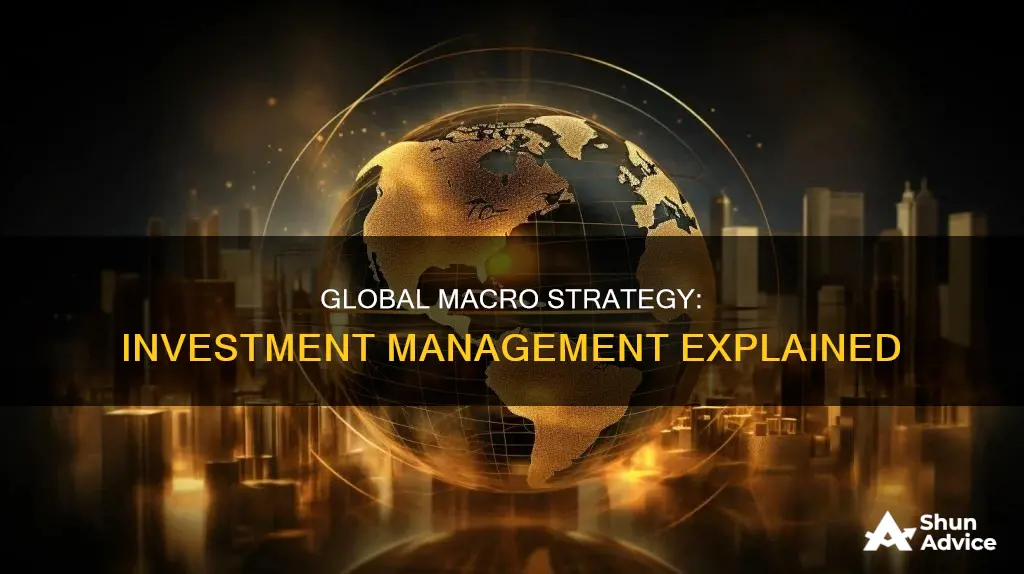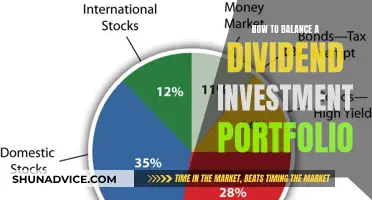
Global macro strategy is an investment and trading strategy that leverages macroeconomic and geopolitical data to predict and profit from broad market swings. These strategies are typically employed by hedge funds and mutual funds, which analyse various factors such as interest rates, currency exchange rates, international trade, and political events to make investment decisions. Global macro funds are considered to be among the least restricted, allowing them to invest in a diverse range of assets worldwide. The goal is to maximise returns by capitalising on large-scale macroeconomic and geopolitical trends.
| Characteristics | Values |
|---|---|
| Type of strategy | Investment and trading strategy |
| Focus | Interpreting and predicting large macroeconomic events |
| Scale | National, regional, and global |
| Data leveraged | Macroeconomic and geopolitical |
| Impact | Disproportionately impacts certain sectors, e.g., energy, commodity, and currency markets |
| Forecasts and analysis | Interest rate trends, international trade and payments, political changes, government policies, and international relations |
| Funds | Hedge funds and mutual funds |
| Holdings | Long and short positions in various equity, fixed income, currency, commodities, and futures markets |
| Management | Actively managed |
| Risk | Least restricted funds |
| Trading strategies | Currency-based, interest rate-based, and stock index-based |
| Fund types | Discretionary, commodity trading advisor, and systemic |
What You'll Learn

Currency strategies
The relative value of currencies plays a significant role in currency strategies. For instance, if a fund manager anticipates a recession in a particular country, they may short-sell the country's currency. On the other hand, if they foresee robust economic growth in another country, they may take long positions in that country's currency. These strategies can provide substantial returns due to the leveraged nature of currency trades.
However, it is important to note that currency strategies come with a certain level of risk. The high leverage inherent in currency trades can amplify both gains and losses. As such, fund managers must carefully assess and manage these risks to ensure that potential losses do not outweigh the potential rewards.
Overall, currency strategies are a key tool for global macro investment managers, enabling them to navigate the complex landscape of international currencies and capitalise on opportunities presented by shifts in the relative strength of currencies.
Portfolio Diversification: An Investment Strategy Guide
You may want to see also

Interest rate strategies
The investment vehicles used in this strategy include government debts, such as US Treasury Bills, and derivatives based on these securities. Fund managers may also invest in sovereign debt from other developed and emerging countries, making directional bets and relative value trades.
Global macro funds using interest rate strategies monitor and project economic and monetary policies worldwide. They make highly leveraged trades using futures, forwards, options, and spot transactions.
Interest rate modelling, which came into use in the 1970s, is a key tool for predicting moves in foreign currency markets and sovereign debt.
Diversifying Taxable Investment Portfolios: Strategies for Long-Term Success
You may want to see also

Stock index strategies
Global macro funds, often hedge funds or mutual funds, use stock index-based strategies to capitalise on opportunities in the market. These funds are actively managed and have higher investment thresholds and fees. They aim to build portfolios that outperform the index during lower interest rate environments by focusing on liquid assets that can be easily traded during uncertain times.
The key to successful stock index strategies is the interpretation of macroeconomic and geopolitical factors. Fund managers analyse interest rates, currency exchange rates, international trade levels, political events, and international relations. By understanding these factors, they can make informed decisions about the potential performance of a country's equity index.
One example of a stock index strategy is the use of futures, options, and exchange-traded funds (ETFs). Fund managers employ these tools to create portfolios that aim to outperform the index. They focus on liquid assets to minimise market risks and avoid liquidity or credit risks.
Additionally, some global macro funds specialise in emerging markets, seeking opportunities in countries with high growth potential. These funds are often flexible, allowing managers to take long or short positions with various assets worldwide.
Investing More, Saving Less: Surplus Secrets
You may want to see also

Commodity trading
CTA funds are a type of managed futures fund, where managers trade futures contracts on behalf of their clients. These contracts can be traded on stock indices, commodities, volatility indices, currencies, and interest rates. While managers may take a discretionary approach, they are restricted to trading in futures contracts only.
Macro investors may buy or short commodities as part of their broader investment strategy. For example, if a macro investor predicts that the US economy is heading towards a recession, they may start shorting commodities that are closely tied to economic growth, such as industrial metals. On the other hand, if the outlook for a country with a large agricultural sector, like Brazil, is strong, a global macro investor may choose to buy commodities such as coffee or soybeans.
Investing Savings Wisely: Your Path to Home Ownership
You may want to see also

Systematic trading
Systematic global macro funds use fundamental analysis to build portfolios and execute trades using algorithms. This type of fund is a hybrid of discretionary global macro and CTA funds. Systematic strategies employ quantitative models to determine trading decisions. Models are specified upfront and ideally change infrequently.
Systematic global macro funds take both long and short positions in a range of global equity, bond, currency, and commodity markets. They use exchange-traded and over-the-counter (OTC) futures and forward foreign exchange contracts, swaps on commodity indices, equity indices and equities, and index options and other investments.
Systematic global macro funds aim to profit from mean reversion by buying markets that they believe are depressed in price and shorting markets that they believe are trading at inflated values. They model investor sentiment to deal with the uncertainty of timing.
Systematic global macro funds are based on three key factors: carry, momentum, and value. These factors operate within the global macro context and can be used in systematic global investment strategies as a diversifying alternative source of investment returns.
A portfolio of 12 individual strategies using stocks, bonds, currencies, and commodities delivers a package of carry, momentum, and value that generates strong absolute returns at moderate levels of risk and leverage. These systematic global investment strategies may provide an attractive and diversifying alternative source of investment returns compared to the low yields and low returns offered by mainstream stocks and bonds.
Systematic strategies have the advantage of being more transparent and lower cost than the typical global macro hedge fund. They rely on signals that measure well-documented return factors.
Portfolio Investment: Global Reach and Diversification
You may want to see also
Frequently asked questions
A global macro strategy is an investment strategy that bases its holdings on the interpretation of large macroeconomic events and their impact on the national, regional, and global markets.
The three main types of global macro strategies are currency-related, interest rate-related, and stock or equity index-related.
Some examples of global macro funds include Bridgewater Associates, Element Capital Management, and Moore Capital Management.
Global macro strategies offer investors exposure to high-level bets that span across various assets and instruments, providing a form of diversification that is attractive to investors seeking protection from global financial events that can impact stock and bond returns.







